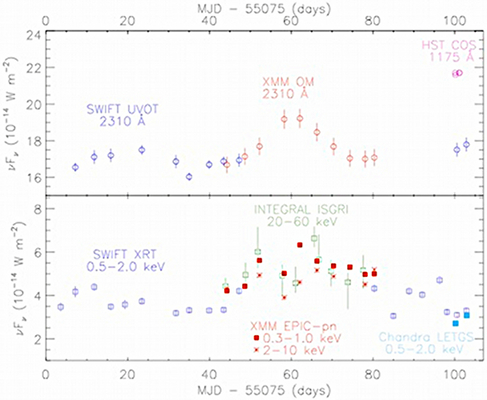
 Credit: J. S. Kaastra et al., (2011, A&A 534, A36); ESA; NASA
Credit: J. S. Kaastra et al., (2011, A&A 534, A36); ESA; NASA
Black Hole Burps
Deep at the center of nearly every galaxy lies a large, distorted region of spacetime. This region is produced by the presence of a supermassive black hole, as massive as a large star cluster or small galaxy squeezed into a space no bigger than our solar system. Some of these monsters are dormant and difficult to see, a trap for the unwary interstellar traveler. Others are more active and easier to see. While it's impossible to escape from a black hole once you're in it, sometimes foolhardy but lucky material which wanders too close to the black hole finds a way out, accelerated to nearly the speed of light and ejected away from the black hole for enormous distances. How this happens is a puzzle which has concerned astronomers for more than forty years. To help answer this, for 100 days a team of 26 astronomers from 21 institutes on four continents trained nearly every space-based observatory on a particularly active supermassive black hole in the nucleus of a distant galaxy called Markarian 509. The image above shows the brightness variation of the black hole's ultraviolet (top) and X-ray (bottom) emission, as measured by Swift, XMM, INTEGRAL, Chandra, and Hubble during this observing campaign, starting on September 1, 2009. One important result of this campaign is to show, for the first time, where and how this outflow of escaping material originates. The campaign showed that the outflow consists of giant "bullets" or clumps of matter propelled at millions of kilometers per hour originating from a dusty reservoir of matter located at a surprising distance, more than 15 light years away from the edge of the black hole.
Published: October 10, 2011
<
HEA Dictionary ● Archive
● Search HEAPOW
● Other Languages
● HEAPOW on Facebook
● Download all Images
● Education ● HEAD
>

Each week the HEASARC
brings you new, exciting and beautiful images from X-ray and Gamma ray
astronomy. Check back each week and be sure to check out the HEAPOW archive!
Page Author: Dr. Michael F. Corcoran
Last modified Monday, 26-Feb-2024 17:10:53 EST


